Violent far-right groups in Europe
The security services are hunting for Islamic terrorists and tripping over the extreme right
Right-wing populism had a good year in 2016. The Brexit referendum and Donald Trumpâs victory, as well as the successes and excesses of strong-man rulers around the world, have left many feeling the right is ascendant, for good or ill. I have already written about the growing prominence of right-wing populist parties in Europe who are likely to do well electorally in 2017, including the National Front in France, the Dutch Freedom party and Germanyâs Alternative For Germany (AfD). Concurrently and connectedly we are seeing an increase in violent right-wing criminal and terrorist activity in Europe. We will look at right wing terrorist groups, crimes and actors, and examine their motives and techniques.
Right-wing violent extremist groups are only loosely united, so a broad definition will have to suffice. Right-wing extremism involves extreme social conservatism and ethno-nationalism/white supremacy. A fictional and âsuperiorâ ethnically and culturally homogenous golden age of the nationâs history is yearned for. Fascist, Nazi and antisemitic ideas and symbols are common as is disdain for both democracy.
Right-wing extremist groups are on the march now. They are fuelled by the same anti-establishment anger which is benefiting populist parties throughout Europe. They are also taking advantage of public concern with immigration as a consequence of Europeâs migrant crisis, and more general multicultural and socially liberal policies. However, even in their present form (i.e. ignoring the fascist organisations of the 20th century) they are merely the latest sproutings of an enduring idea.
Norway is a good example of the 21st centuryâs European fascism. In 2001 two members of the neo-Nazi âBootboysâ murdered Benjamin Hermansen, son of a Ghanaian father and a Norwegian mother. Another neo-Nazi party, Vigrid, has also unsuccessfully contested several elections despite a membership including violent criminals. Anders Breivik is the most notorious example, killing 77 people in 2011. His ranting manifesto contained many cliches of the far right. He wanted to deport Muslims and believed European society was weak and decadent. These tropes are common among 2017âs extreme right.
Despite heroic efforts by Germans to put their countryâs dark history behind them, Germany also had trouble with the far right before PEGIDAâs rise to prominence. The Nationalsozialistische Untergrund (Nazi Underground) organisation robbed, murdered and bombed their way around Germany between 2001 and 2006. Their crimes were racially motivated, focusing on people of Turkish extraction the same way in Germany those of Arab extraction have come under attack.
Norway and Germany both illustrate the continuity in the far right threat faced in Europe today. What motivated Breivik and the Zwickau cell still motivates those all over the continent.
UK
The UK classed the far-right group National Action as a terrorist organisation under anti-terror legislation, the first non-Islamist group to suffer this fate. This criminalisation is linked to the murder of MP Jo Cox by Thomas Mair. Thomas Mair harbours fascist and neo-Nazi beliefs and though he acted alone, National Action members exhibited explicit and illegal support for Coxâs murder. Belonging to National Action is now a criminal offence and those claiming membership are classed as terrorists despite there being no violent action linked directly to the organisation. The treatment of National Action shows why it is so hard to police far-right groups: National Actionâs rhetoric, and the rhetoric of organisations like National Action (in Mairâs case, American extreme far-right groups) are perceived to incite people to violence without explicit order or instruction, and often within the legal limits of free speech. The actual criminals are often only tangentially connected to the groups operating in that particular country. The difficulty is in policing poisonous attitudes which do drive people to violence without allowing far right organisations to present themselves as victims of the censorious state, and without infringing on peopleâsâ rights to express their political opinions.
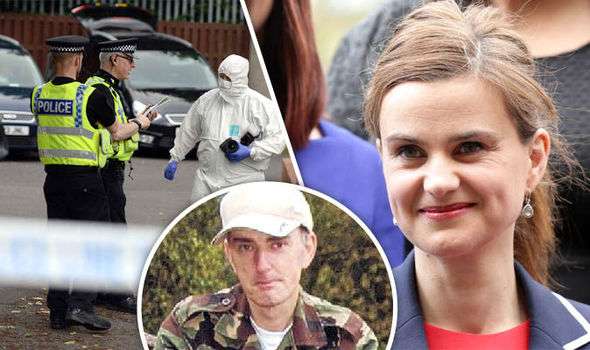
Thomas Mair murdered MP Jo Cox.
The UK also endures the English Defence League, which has avoided proscription despite its membersâ frequent violent conduct and campaigns of intimidation against Muslims. 50 members of the EDL were arrested following a protest in Birmingham in 2013. Members of the organisation were filmed throwing bricks at members of the public and police officers. In 2015 they marched through Dudley in protest of the construction of a mosque chanting âif you hate all Pakis clap your handsâ. 29 were arrested, one for assaulting a police officer.
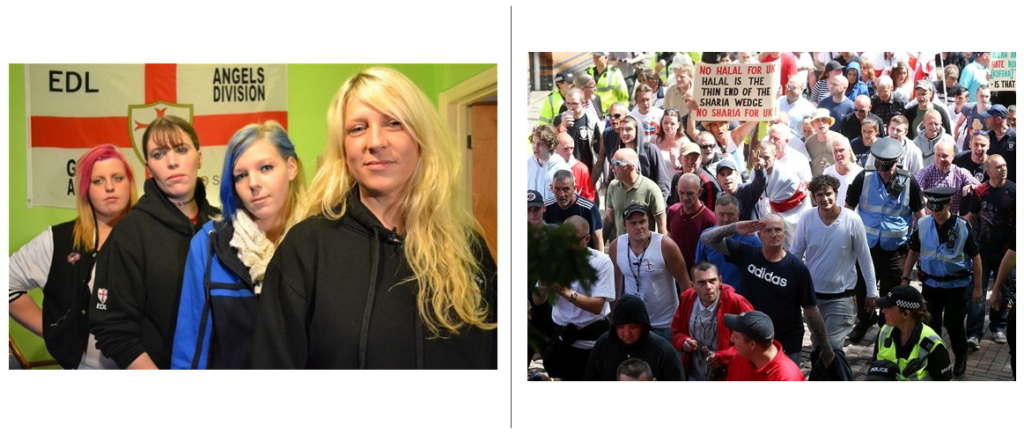
The English Defence League (EDL) is a far-right street protest movement which focuses on opposition to what it considers to be a spread of Islamism and Sharia in the United Kingdom.
France
Franceâs Front National party, lead by Marine Le Pen, looks likely to make it to the second round of, or even win, the presidential election this year. She has made great strides in making the party more politically palatable, but it is the same party as that led by her father Jean-Marie Le Pen, who described the Holocaust as a âdetailâ of history. There are still anti-Semites and fascists in the National Front today.
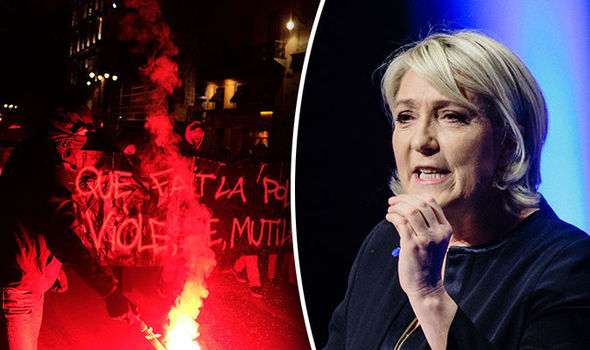
Half of French police say they would consider backing The National Front as Le Pen pledges to crackdown on street chaos
Furthermore, there have been multiple Islamist acts of violence in France in the last couple of years, including the Charlie Hebdo office attack, the Paris shootings and the Nice truck attack. These all drive far right violence in response, for example following the Paris attacks in November 2015 a mob attacked a Muslim prayer room in the Corsican capital of Ajaccio and attempted to burn a Koran. They chanted âArabs outâ. There have also been attacks on refugees by organised gangs around the Calais âJungleâ camp. The NGO Care4Calais has blamed âright-wing militiasâ.
Belgium
Like Corsica, Belgium experienced violence following a terrorist attack. Followng the Brussels terror attack in March 2016 memorial services were invaded by approximately 340 hooligans appeared waving flares and fascist salutes and shouting nationalist slogans. The hooligans were affiliated with football clubs.
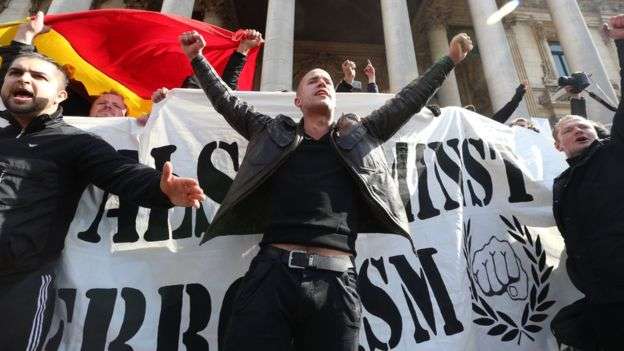
They carried a banner saying Casuals Against Terrorism up the steps of the Stock Exchange building in Brussels.
Germany
Germanyâs PEGIDA organisation has a name which is also a mission statement, standing for âPatriotic Europeans Standing Against the Islamisation of the Westâ. German far right groups have been concerned with what they perceive as the increasing cultural and demographic power of Muslims and immigrants in their country (consider the âHooligans against Salafistsâ street gangs), which has only increased after the influx of refugees following the European migrant crisis.
The German intelligence services have warned of an increase in far-right violence, particularly against asylum-seekers. Attacks since 2015 have increased by 42%, including 75 arson attacks on refugee centres (up from five in 2015). The report also stated there are c.11,800 violent far-right extremists in Germany.
Germany has suffered a spate of Islamist terror attacks during 2016. The Berlin Christmas market attack was the most bloody, but during the summer there were frequent, smaller attacks as well. Two attacks, in Stuttgart and Munich, were not Islamist terror attacks despite initially being reported as such, but this does not change the perception by far-right groups that Germany is besieged and infiltrated by outsiders who refuse to integrate: the anti-immigration far-right AfD party blamed Angela Merkelâs immigration policy for the violence despite none of the attackers being refugees.
Austria
On May 22nd 2016 a neo-Nazi rampaged through a concert, killing two people and injuring 12 before shooting himself. Salon reports that he had been an active fascist skinhead with convictions for violent crimes. A week later another neo-Nazi was arrested for planning a massacre of refugees. Police found weapons, ammunition and Nazi memorabilia in his house. In December of 2016 Norbert Hofer was narrowly defeated in the Austrian presidential elections. Hofer holds far-right views and carries a handgun, which he describes as a ânatural consequenceâ of immigration, and encourages gun ownership âgiven current uncertaintiesâ. In short, many hundreds of thousands of Austrians support a man who overtly believes immigrants pose a physical threat to his safety. The need for this sort of âsafety precautionâ in the face of dangerous immigrants is a recurring justification for right-wing paramilitary and street organisations, as illustrated by the neighbourhood patrols of the Soldiers of Odin, below.
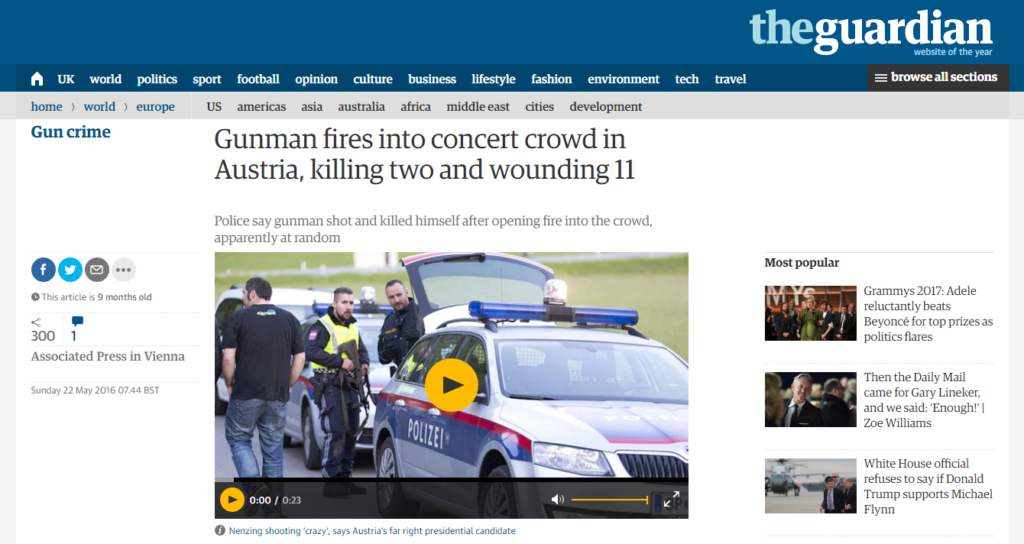
Finland
Finland is home to the violent street organisation the Soldiers of Odin, who have been successful in exporting their brand overseas, with branches opening in the UK, Canada and the US. The Finnish Soldiers of Odin draw their support from those concerned that Muslim refugees and immigrants in Finland are dangerous criminals.
Greece
Following a startling performance in the 2012 Greek elections, Golden Dawn had 18 MPs in Parliament and increasingly favourable polls. However, the murder of left-wing activist Pavlos Fyssas by an admitted member of the party led to mass protests and a police investigation and ultimately the arrest of several MPs. However, the organisation is back on the move, attacking journalists and refugees.
Sweden
Far-right groups linked to football gangs rampaged through Stockholm following the murder of a Swede by a Somalian refugee. Sweden has taken a disproportionate number of refugees and has experienced a surge of far-right violence as well as the increasing popularity of the previously marginalised far-right Swedish Democrats.
Ukraine
Ukraine has its own far-right extremists, but they differ from their western cousins in a number of ways. Ukrainian far-right and neo-Nazi organisations (notably Svoboda, Right Sector and the Azov Battalion) are involved in the proxy conflict in the east of the country. Foreign Policy describes the organisations as ultranationalist, radical, racist and homophobic with sizeable paramilitary cadres. Though the volunteer battalions they raised were vital in checking separatist advances their loyalty to the state is dubious, as illustrated when a Svoboda member killed four National Guardsmen in front of the parliament building.
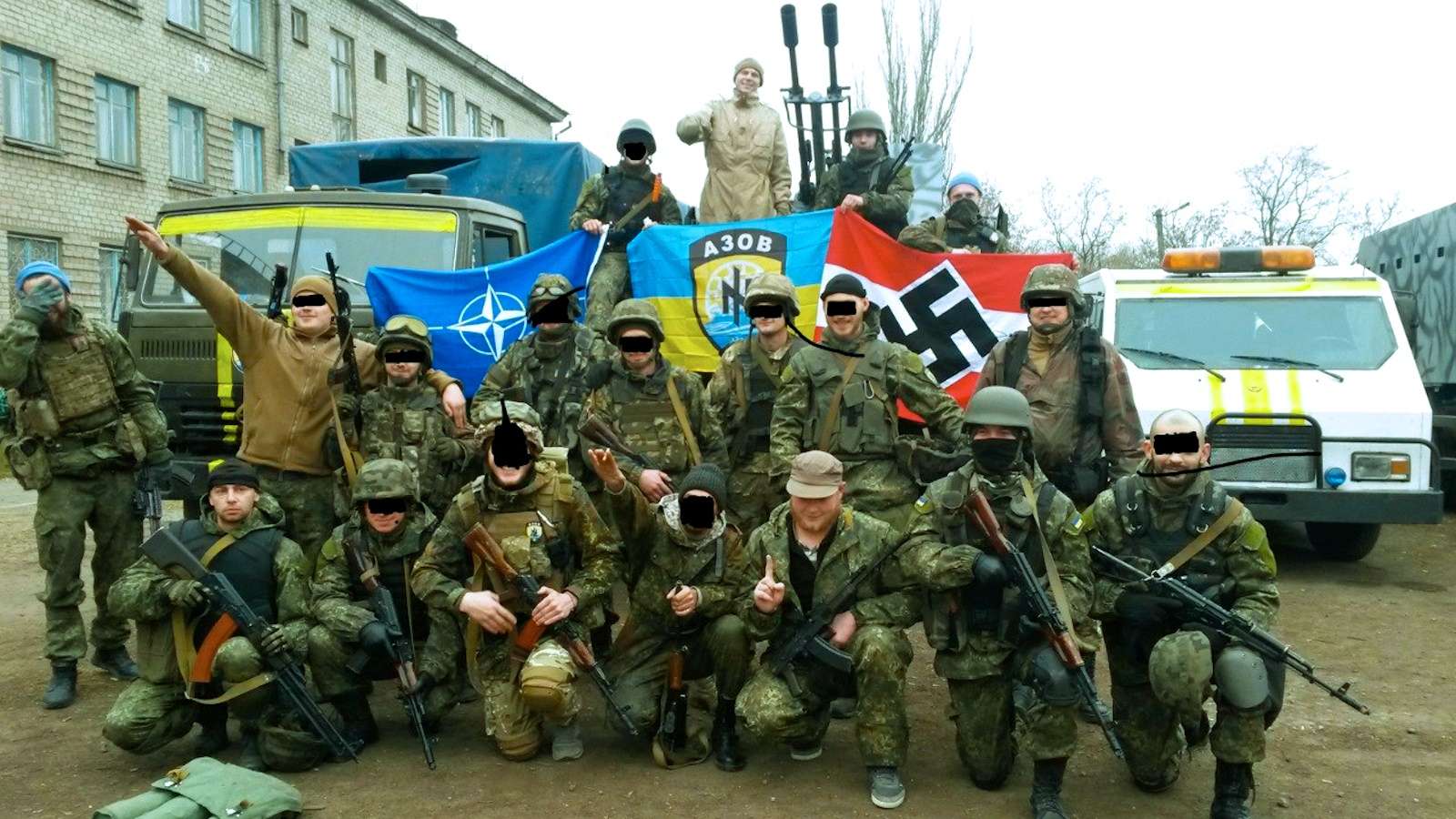
Right Sectorâs political ideology has been described as ultranationalist, neofascist or far right.
While Ukraine is under existential threat from Russia it seems unlikely these groups will turn too savagely on the Ukrainian government. However if we look to the future there seems the possibility of battle-hardened, zealous and armed Ukrainian extremists becoming involved with other European extreme-right groups.
Lone wolves
The growth of the far right is beyond dispute. However, the truly deadly sprays of violence emerging from this trend have been perpetrated by âlone wolvesâ. RUSI has conducted an interesting investigation into the phenomenon of the far right lone wolf killer: a man (for it is almost always a man) driven to violence not by active recruitment but by the bile and poison which can be found online and which can drive people to commit terrible acts of violence if they are of a certain disposition and are exposed to it for long enough. Thomas Mair is a very typical example: he was not part of a sinister cabal of Nazis waiting in the wings for a revolution to usher them into Downing Street. He is a mentally troubled man attracted to ugly ideas and who eventually felt compelled to act.
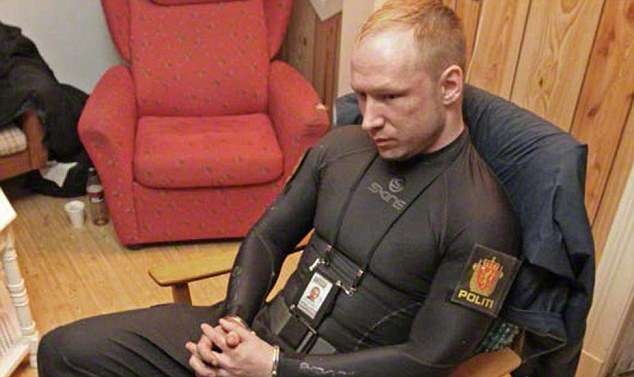
Lone wolf, Anders Breivik killed 77 in Norweigan massacre.
What next?
This is not to say that we are powerless to prevent future incidents. The RUSI investigation observed 40% of far-right extremists were discovered by the authorities by chance, either when the attacker made an error (the Austrian man discussed above texted a friend his murderous intentions to a friend who called the police) or in the course of a separate investigation. Meanwhile 80% of Islamist attacks are prevented by active police and intelligence operations. In short, the security services are hunting for Islamic terrorists and tripping over the extreme right. Dangerously, the Trump administration has decided to focus exclusively on Islamic extremism. This is bad for America and for Europe. Mair was radicalised by American far-right extremists and there are documented connections between the European and American extreme right. In short, the police services of Europe must bear in mind the risk from the right is as potent as that from ISIS or any other Islamist group, especially when we consider the symbiotic relationship between Islamist and extreme right attacks, in which one inspires the other.
Secondly hate speech must be tackled, but with restraint and respect for the law. Where people call for violence they should be punished, but just as states must be careful not to conflate religious conservatism in the Islamic community with extremism, they must not view very right-wing people as automatically potential criminals. The success of the National Front, the Freedom Party, AfD and others shows that millions of Europeans hold very right-wing views and if they are treated as potential domestic terrorists it will play into the hands of extremist groups who argue the state is not on the side of the average citizen. We should encourage people of any political ideology to engage and debate rather than conspire only with the like-minded. It is when ideas are not given a proper airing that they can become poisonous.
Report written by Brendan Clifford
